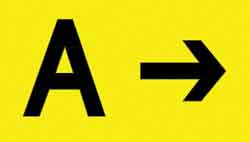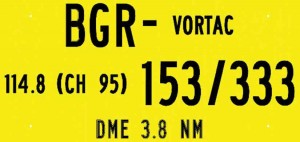by Hal Davis
WisDOT Bureau of Aeronatuics
Published in Midwest Flyer – June/July 2017 issue
Humans tend to be creatures of habit. And while routines and habits may be helpful in some situations, they can be downright dangerous in others. For example, ask any automobile driver and they’ll tell you a stop sign requires you to bring your car to a complete stop. Yet how many drivers are in the habit of just rolling through them? While routinely rolling through a stop sign on a seemingly always empty street may not seem like a big deal, that bad habit could result in a crash at a less empty intersection. Likewise, performing tasks subconsciously out of habit can also inhibit our ability to recognize and react to unexpected changes.
In previous Aeronautics Reports, we’ve examined airport markings and how they can help pilots maintain good situational awareness. The same can be said for airport signs. While I expect the meaning of most airport signs are well known to readers of this magazine, I encourage you to use this opportunity to not only review the textbook meaning of certain airport signs, but also reflect on your own personal habits as they relate to navigating the airport environment. While there’s no such thing as a “rolling stop” for airplanes, pilots are not immune to forming bad habits of their own.
Types of Signs
There are seven types of signs that can be found on an airport: mandatory instruction, boundary, location, direction, destination, information, and runway distance remaining. Many of these signs complement and even replicate airport markings.
Mandatory Instruction Signs
Mandatory instruction signs come in several forms, but they all share the same general purpose, to indicate the entrance to safety critical areas, such as a runway. They feature white text on a red background. At an airport with an operating air traffic control tower, aircraft are generally required to hold at these signs until cleared to proceed by air traffic control. At an uncontrolled airport, aircraft are expected to verify that the area they are entering is free of conflicting air traffic before proceeding beyond the sign.
It’s a good habit to always look both ways
before crossing any holding position sign,
even if you’ve been cleared to do so by air traffic control.
 The most common mandatory instruction sign is the runway holding position sign. Located at the intersection of a taxiway and runway or the intersection of two runways, runway holding position signs depict the designation of the intersecting runway. The runway numbers are separated by a dash, and their arrangement indicates the direction to the corresponding runway threshold. For example, a runway holding position sign that reads “18-36” would mean the threshold for runway 18 is to the left and the threshold for runway 36 is to the right. At an intersection with a runway end, only the designation for the takeoff runway is displayed on the sign. Arrows are also used to illustrate the orientation of each runway when a taxiway intersects two runways at the same location.
The most common mandatory instruction sign is the runway holding position sign. Located at the intersection of a taxiway and runway or the intersection of two runways, runway holding position signs depict the designation of the intersecting runway. The runway numbers are separated by a dash, and their arrangement indicates the direction to the corresponding runway threshold. For example, a runway holding position sign that reads “18-36” would mean the threshold for runway 18 is to the left and the threshold for runway 36 is to the right. At an intersection with a runway end, only the designation for the takeoff runway is displayed on the sign. Arrows are also used to illustrate the orientation of each runway when a taxiway intersects two runways at the same location.
 Besides intersections with runways, mandatory instruction signs are also used to indicate several other important boundaries. At some airports, a taxiway may not intersect with the runway itself, but instead intersect with a runway approach area or the runway safety area. Accordingly, it may be necessary for aircraft to hold on the taxiway as to not interfere with traffic on the nearby runway. The runway approach area holding sign indicates this location on the taxiway. The sign’s inscription includes the runway designation for the approach, followed by a dash and the letters “APCH.”
Besides intersections with runways, mandatory instruction signs are also used to indicate several other important boundaries. At some airports, a taxiway may not intersect with the runway itself, but instead intersect with a runway approach area or the runway safety area. Accordingly, it may be necessary for aircraft to hold on the taxiway as to not interfere with traffic on the nearby runway. The runway approach area holding sign indicates this location on the taxiway. The sign’s inscription includes the runway designation for the approach, followed by a dash and the letters “APCH.”
 Similarly, some taxiways may also impact Instrument Landing System (ILS) critical areas. To protect against signal interference, these areas must be cleared of all physical obstructions (including aircraft) when in use. ILS critical area holding position signs are inscribed simply with the letters “ILS.” In addition, runways with more advanced category II and III landing systems may have additional holding position signs installed on parallel taxiways. The inscription on a holding position sign for these types operations is the associated runway designation followed by a dash and the abbreviation “CAT II/III.”
Similarly, some taxiways may also impact Instrument Landing System (ILS) critical areas. To protect against signal interference, these areas must be cleared of all physical obstructions (including aircraft) when in use. ILS critical area holding position signs are inscribed simply with the letters “ILS.” In addition, runways with more advanced category II and III landing systems may have additional holding position signs installed on parallel taxiways. The inscription on a holding position sign for these types operations is the associated runway designation followed by a dash and the abbreviation “CAT II/III.”
Boundary Signs
 On the backs of all holding position signs are boundary signs, which identify the boundary for aircraft leaving a particular safety critical area. For instance, the runway safety area/runway approach boundary sign is found on the backs of runway holding position signs and runway approach area holding position signs. These signs provide pilots a visual que they are exiting the runway safety area. This sign feature a yellow background with a black inscription depicting the two solid and two dashed lines that make up the holding position marking.
On the backs of all holding position signs are boundary signs, which identify the boundary for aircraft leaving a particular safety critical area. For instance, the runway safety area/runway approach boundary sign is found on the backs of runway holding position signs and runway approach area holding position signs. These signs provide pilots a visual que they are exiting the runway safety area. This sign feature a yellow background with a black inscription depicting the two solid and two dashed lines that make up the holding position marking.
 Likewise, ILS critical area boundary signs can be found on the backs of ILS critical area holding position signs, as well as CAT II/III operations holding position signs. These signs feature a yellow background with a black inscription depicting the ILS critical area marking. Aircraft must pass by these signs and associated markings completely before considered clear of the ILS critical area.
Likewise, ILS critical area boundary signs can be found on the backs of ILS critical area holding position signs, as well as CAT II/III operations holding position signs. These signs feature a yellow background with a black inscription depicting the ILS critical area marking. Aircraft must pass by these signs and associated markings completely before considered clear of the ILS critical area.
Location Signs
 Location signs are used to identify the taxiway or runway on which an aircraft is located. Location signs feature a black background with a yellow border and yellow text. These signs may be installed by themselves, but are most commonly collocated with direction signs or runway holding position signs. While taxiway location signs are common, runway location signs are typically only installed where the proximity of two or more runways may cause confusion as to which runway an aircraft is on.
Location signs are used to identify the taxiway or runway on which an aircraft is located. Location signs feature a black background with a yellow border and yellow text. These signs may be installed by themselves, but are most commonly collocated with direction signs or runway holding position signs. While taxiway location signs are common, runway location signs are typically only installed where the proximity of two or more runways may cause confusion as to which runway an aircraft is on.
Typically, letters are used to name taxiways.
However, there are three letters which are never used.
Can you name them?*
Direction Signs
 Whereas location signs tell you where you are, direction signs tell you which taxiway you are crossing at a particular intersection. Located on both taxiways and runways, direction signs feature a yellow background with black text and always at least one arrow pointing in the direction of the crossing taxiway. They are normally located on the left prior to an intersection; however, on a runway, direction signs will be located on the same side as the exit to prevent confusion.
Whereas location signs tell you where you are, direction signs tell you which taxiway you are crossing at a particular intersection. Located on both taxiways and runways, direction signs feature a yellow background with black text and always at least one arrow pointing in the direction of the crossing taxiway. They are normally located on the left prior to an intersection; however, on a runway, direction signs will be located on the same side as the exit to prevent confusion.
Destination Signs
 Similar in appearance to direction signs, information signs also feature a yellow background with black text and an arrow. While direction signs are used exclusively to identify taxiways, destination signs are used to provide directional information for outbound destinations, such as runways and inbound destination, such as aprons, fuel, cargo areas, international areas, FBOs, terminals, and military areas. When two or more destinations have the same taxiing route, the destinations are separated on the sign by a dot and a single arrow is used to point in the direction of the destination. Conversely, when a destination sign contains two or more destinations with different taxi routes, each destination will be accompanied by an arrow with a vertical black message divider separating the two.
Similar in appearance to direction signs, information signs also feature a yellow background with black text and an arrow. While direction signs are used exclusively to identify taxiways, destination signs are used to provide directional information for outbound destinations, such as runways and inbound destination, such as aprons, fuel, cargo areas, international areas, FBOs, terminals, and military areas. When two or more destinations have the same taxiing route, the destinations are separated on the sign by a dot and a single arrow is used to point in the direction of the destination. Conversely, when a destination sign contains two or more destinations with different taxi routes, each destination will be accompanied by an arrow with a vertical black message divider separating the two.
Information Signs
 Some airports may be compelled to provide additional information to pilots through the use of information signs. These signs also feature a yellow background with black text. Common examples of information displayed on these signs include VOR checkpoint information, noise abatement procedures, and radio frequencies.
Some airports may be compelled to provide additional information to pilots through the use of information signs. These signs also feature a yellow background with black text. Common examples of information displayed on these signs include VOR checkpoint information, noise abatement procedures, and radio frequencies.
Distance Remaining Signs
 Finally, distance remaining signs provide pilots distance remaining information for takeoff and landing. These signs are located along one or both sides of the runway and feature a white numeral on a black background. The numeral indicates the number of thousands of feet remaining for the runway. On short, turf runways, where the opposite runway end is not visible, a single sign depicting “½” is placed midway down the runway denoting that only half of the runway remains.
Finally, distance remaining signs provide pilots distance remaining information for takeoff and landing. These signs are located along one or both sides of the runway and feature a white numeral on a black background. The numeral indicates the number of thousands of feet remaining for the runway. On short, turf runways, where the opposite runway end is not visible, a single sign depicting “½” is placed midway down the runway denoting that only half of the runway remains.
Find Out More
To find out more about airport signs, check out Chapter 2 of the Federal Aviation Administration Aeronautical Information Manual or Advisory Circular 150/5340-18F. Stay tuned for the final chapter in our review of airport visual aids, “airport lights.”
(*Answer: To avoid any confusion, the letters “I”, “O”, “X” are never used to name a taxiway.)